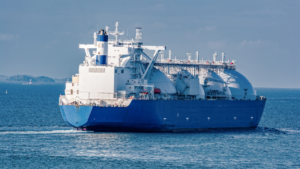LNG – or Liquified Natural Gas – is a substance that is used the world over and is becoming an essential part of the global energy market.
It starts life as an approximately 95% methane natural gas that is then cooled down (through a cycle of compression, condensation, expansion and evaporation) to -160°C, at which point it transforms to a liquid form or ‘LNG’.
Once it is liquified, LNG can be stored and transported safely in very large quantities. Not only is transportation of LNG easier in liquid format, but it is also more practical as once liquified, natural gas is less voluminous and can be stored in a volume 1/600th as large.
Efficient transportation of LNG is essential as it is predominately extracted in countries such as Algeria, Norway, Qatar, Russia, Nigeria and the USA. These places are far away from the end-users of LNG and therefore it is not viable to transport it via gas pipelines.
The easiest and most economical method of transportation is to ship it via LNG tankers that have specially designed thermally insulated tanks, designed to maintain the natural gas in a liquid form.
The specialist materials used to transport LNG have to be carefully sourced to ensure that they can safely contain it. Strong nickel steel alloys have traditionally been used which is where suppliers like Special Piping Materials come in. Our global network of experienced mills and manufacturers allows us to source the most high-performing products in the market. Whether it is storage tanks, pipes or other essential items that are required, we are able to source it.
What is LNG and what are its uses?
Natural Gas is cooled down to liquid form mainly for the ease and safety of non-pressurised storage and transport. When it is in this state (Liquified Natural Gas) it has the advantages of being odourless, colourless, non-toxic and non-corrosive.
These advantages mean that LNG has a variety of different uses and is being trialled in many different industries. It has been evaluated and tested for over-the-road trucking as well as many other off-road, maritime, high-torque engines and rail applications.
As an example, if we look more closely at over-road trucks, in the US, the possibility of a public LNG fuel resource is being explored. There are about 100 public LNG fuel stations across the US which make it possible for large trucks to undertake cross-country journeys and refuel every 500 miles.
The development of the LNG market
The Liquid Natural Gas market is one that has developed relatively slowly over the last century. This is mainly because the majority of LNG plants are remote and difficult to access, subsequently resulting in high transportation costs.
However, new technologies began to emerge in the early 2000s which made it easier to construct plants which, in turn, induced more companies to invest in the liquification process of natural gas. As the market has grown, LNG has become a more viable and competitive means of energy distribution.
More recently, Asia has begun to focus much more on the LNG market, further reducing costs and improving efficiencies across the industry.
How LNG is safely transported
Liquid Natural Gas would not exist if natural gas was easily transportable in its original format. In most cases, LNG is evaporated back to its natural form and then put into local natural gas pipeline infrastructure.
During transportation, it is vital that the benefits of natural gas being non-corrosive and non-toxic when it is in its liquid form are maintained. If LNG is vaporised, then it potentially could become explosive or emit thermal radiation hazards. To prevent this, the materials used to transport and store the liquid gas must be reliable and have the ability to maintain the extremely low temperatures required.
It has been found that nickel steel alloys are the most effective in keeping natural gas at liquefaction temperatures. Steel with 6-9% nickel levels are able to stay ductile and crack resistant due to the fine-grained structure of nickel-ferrite.
These same nickel alloy levels also present strong weldable properties. Where welds are used, they have to be able to be extra tough and resilient to fracture; again, research has found that nickel alloys can withstand temperatures of -196°C without losing toughness.
Nickel is not the only critical material in a nickel steel alloy – the use of stainless steel is also very important as it has a number of advantages of its own. It is highly weldable, has a high resistance to corrosion and does not undergo phase transformations during welding processes. The ability to withstand the impact of very low temperatures comes from a higher ferrite level that is found in high quality stainless steel.
Special Piping Materials and LNG
Special Piping Materials has been able to support the development of the Liquid Natural Gas market for many years by sourcing and supplying high-grade products from reputable mills across the globe.
Our teams have an in-depth understanding of what our clients require and understand the environments that the products we supply have to endure. We understand that our products need to have the right properties that will allow them to perform and have longevity.
As the LNG industry continues to develop, manufacturing companies that build storage and transportation facilities for LNG will need to source large amounts of nickel stainless steel alloys. Special Piping Materials will continue to work closely with both our clients and suppliers to ensure that this need is met.
#LNG #NaturalGas #LiquifiedNaturalGas #Energy #SpecialPipingMaterials #NickelAlloys #StainlessSteel
